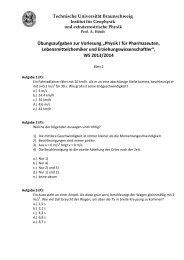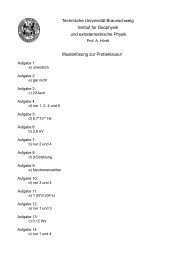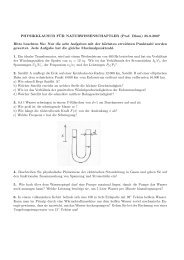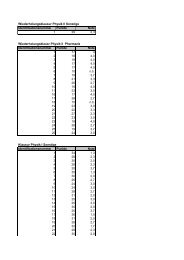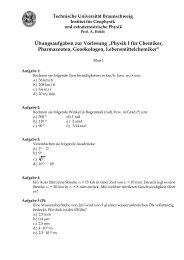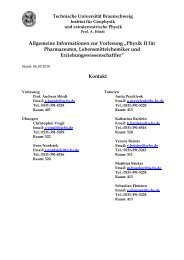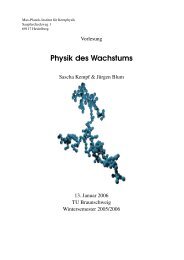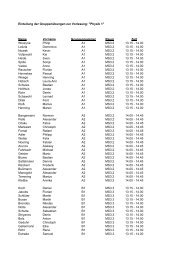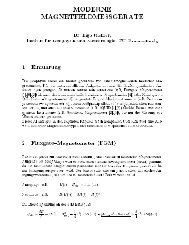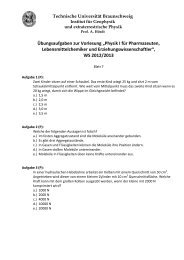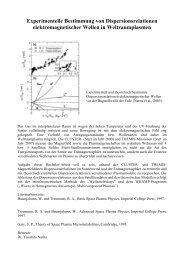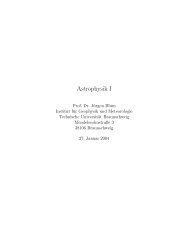Calibrating a Smoothed Particle Hydrodynamics Model for the ...
Calibrating a Smoothed Particle Hydrodynamics Model for the ...
Calibrating a Smoothed Particle Hydrodynamics Model for the ...
Create successful ePaper yourself
Turn your PDF publications into a flip-book with our unique Google optimized e-Paper software.
<strong>Calibrating</strong> an SPH-<strong>Model</strong> <strong>for</strong> <strong>the</strong><br />
Simulation of Collisions between<br />
Pre-Planetesimals<br />
Ralf J. Geretshauser & Roland Speith<br />
Institute <strong>for</strong> Astronomy and Astrophysics, Computational Physics Dep.<br />
University of Tübingen
IAAT,<br />
CPT<br />
<strong>Calibrating</strong> an SPH-<strong>Model</strong> <strong>for</strong> Simulations of Collisions<br />
between Pre-Planetesimals<br />
Situation in <strong>the</strong> accretion disk<br />
• dust agglomerates of centimetre size have <strong>for</strong>med due to<br />
• collisions of dust particles<br />
• sticking by van-der-Waals attraction<br />
• rolling, sliding and reallocation of dust particle chains<br />
• van-der-Waals attraction no longer effective <strong>for</strong> cm and m size regime<br />
Open questions<br />
• How is fur<strong>the</strong>r growth possible?<br />
• Can <strong>the</strong>re be a net growth by collisions?<br />
• Are collisions of centimetre to metre sized objects disruptive?<br />
• How can a fragmentation statistics be derived?<br />
Ralf J. Geretshauser<br />
5th Planet Formation Workshop<br />
2
IAAT,<br />
CPT<br />
<strong>Calibrating</strong> an SPH-<strong>Model</strong> <strong>for</strong> Simulations of Collisions<br />
between Pre-Planetesimals<br />
The need <strong>for</strong> numerical investigation<br />
• experimental setups are limited to centimetre size<br />
• <strong>for</strong> statistics a series of parameter studies have to be per<strong>for</strong>med<br />
The need <strong>for</strong> a porosity model<br />
• dust agglomerates are porous since<br />
• <strong>the</strong>ir growth mechanism results in porous objects<br />
• collisions of brittle objects are always disruptive<br />
Ralf J. Geretshauser<br />
5th Planet Formation Workshop<br />
3
IAAT,<br />
CPT<br />
<strong>Calibrating</strong> an SPH-<strong>Model</strong> <strong>for</strong> Simulations of Collisions<br />
between Pre-Planetesimals<br />
Brittle Material<br />
Porous Material<br />
Ralf J. Geretshauser<br />
5th Planet Formation Workshop<br />
4
IAAT,<br />
CPT<br />
<strong>Calibrating</strong> an SPH-<strong>Model</strong> <strong>for</strong> Simulations of Collisions<br />
between Pre-Planetesimals<br />
The need <strong>for</strong> material parameters and calibration<br />
T 0 = −6 × 10 2 P a<br />
Σ 0 = 6 × 10 2 P a<br />
T 0 = −6 × 10 4 P a<br />
Σ 0 = 6 × 10 4 P a<br />
T 0 = −6 × 10 3 P a<br />
Σ 0 = 6 × 10 3 P a<br />
Ralf J. Geretshauser<br />
5th Planet Formation Workshop<br />
5
IAAT,<br />
CPT<br />
<strong>Calibrating</strong> an SPH-<strong>Model</strong> <strong>for</strong> Simulations of Collisions<br />
between Pre-Planetesimals<br />
The need <strong>for</strong> material parameters and calibration<br />
• provided by experiments with dust<br />
• macroscopic material parameters<br />
• compressive strength<br />
• tensile strength<br />
• bulk modulus<br />
as functions of porosity/filling factor<br />
• Sirono porosity model lacks validation<br />
Blum and Schräpler (2004)<br />
Ralf J. Geretshauser<br />
5th Planet Formation Workshop<br />
6
IAAT,<br />
CPT<br />
<strong>Calibrating</strong> an SPH-<strong>Model</strong> <strong>for</strong> Simulations of Collisions<br />
between Pre-Planetesimals<br />
The need <strong>for</strong> material parameters and calibration<br />
• calibration experiment: glas sphere dropping into a dust cake<br />
• calibration parameters<br />
• deceleration curve of <strong>the</strong> sphere<br />
• density structure underneath <strong>the</strong> impact area<br />
• penetration depth<br />
Ralf J. Geretshauser<br />
5th Planet Formation Workshop<br />
Jens Teiser,<br />
Münster<br />
7
IAAT,<br />
CPT<br />
<strong>Calibrating</strong> an SPH-<strong>Model</strong> <strong>for</strong> Simulations of Collisions<br />
between Pre-Planetesimals<br />
Calibration experiment<br />
X-Ray tomographies by Maya Krause, IGEP Braunscheig<br />
Ralf J. Geretshauser<br />
5th Planet Formation Workshop<br />
8
IAAT,<br />
CPT<br />
<strong>Calibrating</strong> an SPH-<strong>Model</strong> <strong>for</strong> Simulations of Collisions<br />
between Pre-Planetesimals<br />
Preliminary results<br />
Ralf J. Geretshauser<br />
5th Planet Formation Workshop<br />
9
IAAT,<br />
CPT<br />
<strong>Calibrating</strong> an SPH-<strong>Model</strong> <strong>for</strong> Simulations of Collisions<br />
between Pre-Planetesimals<br />
Numerical scheme: Smooth <strong>Particle</strong> <strong>Hydrodynamics</strong> (SPH)<br />
• works with macroscopic quantities (e.g. density, pressure, ...)<br />
• continuous quantities are discretised with sampling points<br />
• sampling points move according to <strong>the</strong> Lagrangian <strong>for</strong>m of EOM<br />
• allows computation of problems with open boundaries<br />
• easy implementation of different materials<br />
• natural integration of de<strong>for</strong>mation and fragmentation<br />
(T. Rabczuk)<br />
Ralf J. Geretshauser<br />
5th Planet Formation Workshop<br />
10
IAAT,<br />
CPT<br />
<strong>Calibrating</strong> an SPH-<strong>Model</strong> <strong>for</strong> Simulations of Collisions<br />
between Pre-Planetesimals<br />
Outlook<br />
• coagulation models need fragmentation statistics and growth rates<br />
• parameter studies of collisions between pre-planetesimals with varying<br />
• impact velocities<br />
• impact angles<br />
• sizes of <strong>the</strong> colliding objects<br />
• object materials<br />
in order to provide fragmentation statistics<br />
• simulation of multiple impacts<br />
• influence of electric charge on fragment distribution<br />
Ralf J. Geretshauser<br />
5th Planet Formation Workshop<br />
11
IAAT,<br />
CPT<br />
<strong>Calibrating</strong> an SPH-<strong>Model</strong> <strong>for</strong> Simulations of Collisions<br />
between Pre-Planetesimals<br />
Thank you <strong>for</strong> your attention!<br />
Ralf J. Geretshauser<br />
5th Planet Formation Workshop<br />
12



